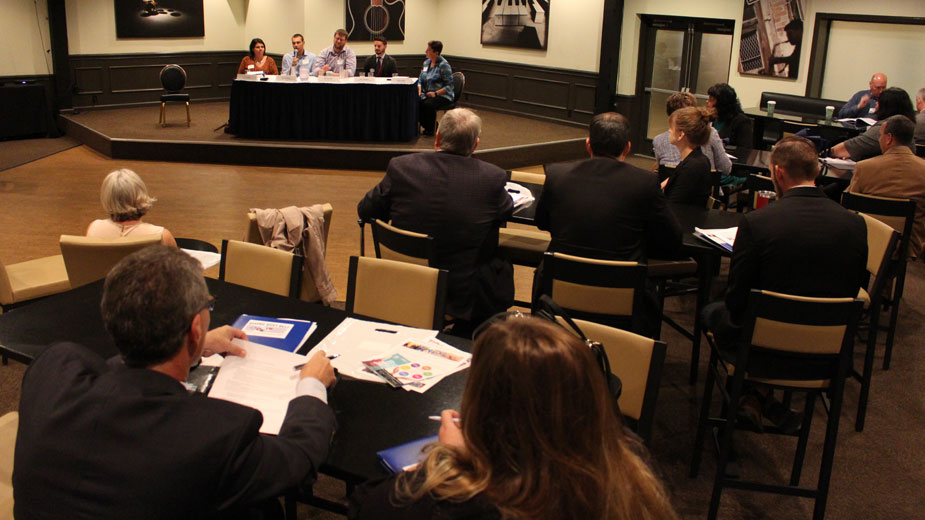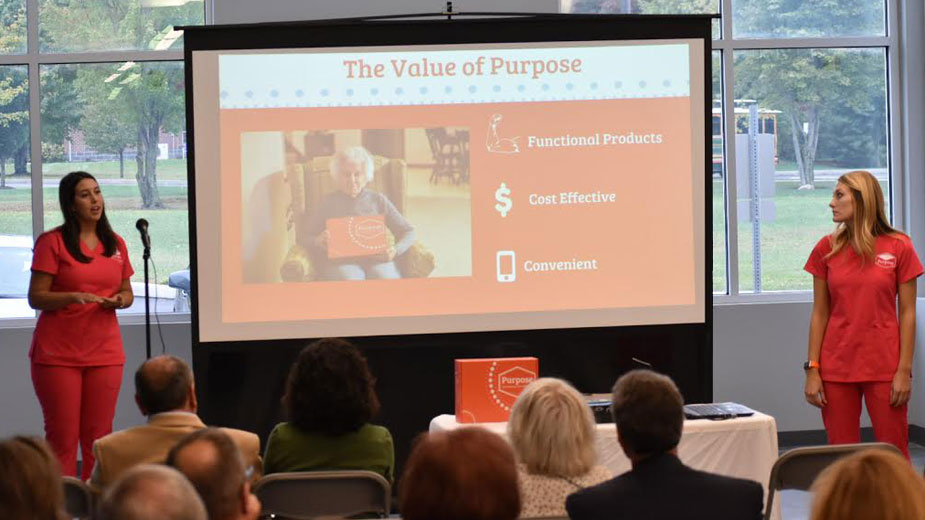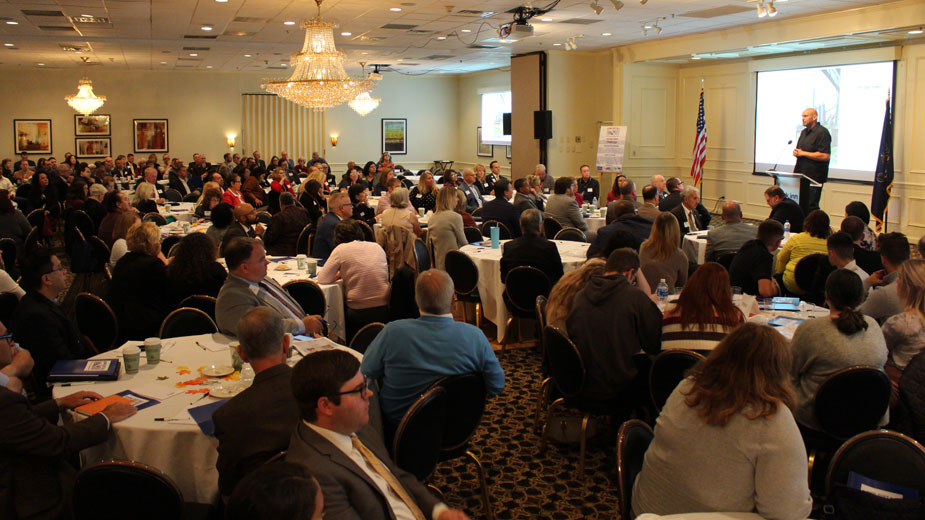At Rising Rust Belt Summit, Renewal Takes Center Stage
WEST MIDDLESEX, Pa. – Pennsylvania Lt. Gov. John Fetterman urged attendees at the inaugural Rising Rust Belt regional revitalization summit to take ownership of the “Rust Belt” term, one often used in derision of communities like the Mahoning and Shenango valleys.
“Own that term. It speaks of possibility. It speaks of renewal,” Fetterman said.
Fetterman’s keynote address Monday morning echoed introductory remarks by James Dignan, president and CEO of the Youngstown/Warren Regional Chamber.
“We’re proud of our legacy,” Dignan said. “Manufacturing is in our bones. It’s in our core. It’s who we are and it’ll be a part of what we do going forward. It’s just going to look and feel different.”
The Youngstown/Warren Regional Chamber, Shenango Valley Chamber of Commerce and Lawrence County Regional Chamber of Commerce, staged the two-day forum, which began Sunday night. The event kicked off with a reception and a tour of The Landing and the Hope Center for Arts and Technology in Sharon.
More than 400 attended Monday’s program at the Radisson here, which included panels and breakout sessions, followed by a pitch competition at the LindenPointe Innovative Business Campus in Hermitage.
“My heart is in places like Sharon. My heart is in places that contributed so much to making our country so great that kind of had their backs turned on them by forces well outside their control,” Fetterman said.
Before becoming lieutenant governor, Fetterman was mayor of Braddock, a borough at the bottom of the economic ladder. It went from a community of more than 20,000 to one that lost almost all of its businesses and of its population.
The community set out to redefine what Braddock could be, beginning with the acknowledgement that it would never again be what it was. Braddock has since turned around, with restaurants opening again and a ribbon cutting this week on an agricultural robotics firm that just received $35 million in venture capital, Fetterman said.
U.S. Steel Corp. also recently invested $1.2 billion at sites in Braddock and Clairton “that ultimately will produce the greenest steel in the entire world,” he added.
That turnaround was accomplished by working with the community’s existing assets, focusing on making the community safer and forging partnerships with economic development agencies, philanthropic groups and public corporations, he said.
Fetterman recounted a slogan he used when he first took office: “Reinvention is the only option.” The notion of being able to “cling to all of the things in the past” doesn’t work, he warned.
“We still have work to do but we’re on the right track,” he said. “If I can definitely tell you that Braddock can and did get significantly better, your communities are miles ahead of where my community was.”
Ohio has come a long way since the Great Recession ended, but its progress is going to require “some really bold ideas, innovation and strong community partnerships,” said Lydia Mihalik, director of the Ohio Development Services Agency, who presented the lunch keynote address.
As unemployment has dropped, companies looking to relocate or expand are more concerned with finding a quality workforce, infrastructure, access to transportation and quality of life than they are about simply finding cheap land.
Mihalik discussed new projects Ohio is launching, including one rolling out in coming weeks that will provide $2.5 million to industry sector partnerships such as the Mahoning Valley Manufacturers Coalition to facilitate local business, education, workforce training and community leaders coming together to develop a plan to get the local workforce ready for the future.
MVMC is “one of the examples that we like to hold up of success,” she said. “That’s our hope – that we can be supportive of those efforts and others in northeast Ohio to make some meaningful progress in our workforce development issues.”
Partnerships will be eligible for up to $100,000 to seed the work of the group.
Mihalik also discussed the recently launched TechCred program, which reimburses employers to train workers to earn qualifying technology-based credentials, which she said would be a catalyst for both workers and employers.
Other topics Mihalik addressed included Ohio’s effort to make its 320 Opportunity Zone sites competitive with the nearly 8,400 other zones throughout the United States by providing a 10% tax credit on top of the federal incentive.
Like Fetterman and Dignan, Mihalik addressed the “Rust Belt” term, one she said isn’t widely used in Ohio because of its negative connotation.
“We are hard-working innovators,” she said. “We are strong, yet nimble. We’re balanced by the promise of the American Dream and we’re coalesced together in our local communities to do great things together in our region. If we don’t believe it ourselves, then how can we expect others to join us?”
Panel discussions during four breakout sessions focused on economic development and entrepreneurship, community development and innovation, government affairs and education, and workforce development and retention.

One of the morning breakout sessions focused on best practices for downtown revitalization.
Getting the public and private sectors to work in line with one another and “less in conflict” would be the “best, best practice we could take,” said Don Thomas, owner of Platz Realty Group in Canfield. In Youngstown, where Platz represents several properties, revitalization of older buildings encounters environmental and historical issues.
“On the private sector side, we constantly seem to fight the bureaucracy on the city level, as well as the state and federal level,” he said.
“Just start somewhere,” advised Melissa Phillips, community and economic development director for the city of Sharon. In her hometown of Warren, Ohio, downtown activity was spurred by using vacant spaces as pop-up shops, providing people a chance to see the space for what it could be and giving retail startups a foothold.
One of the shops, done in partnership with Youngstown State University on 2014, offered logo and website design services. “It actually brought people downtown when they hadn’t really been there for a while,” she said. “It started to allow people to see the potential.”
Sharon Letson, executive director of Youngstown CityScape, agreed with the importance of beginning somewhere. In Youngstown, that starting point was planting flowers 20 years ago, then encouraging the city to turn on lights.
“As the years went by, what you did was continue to raise the standard,” she said. Recent successes include the rehabilitation of Wick Avenue and the annual Streetscape community planting and cleanup day, which this year drew more than 700 downtown.
“It starts with understanding your community. That’s the most important thing,” Letson added. That includes the people who live there, the people who work there and the government.
Angie Urban, executive director of New Visions for Lawrence County, emphasized looking at people in the community as the greatest asset rather than waiting on outside agents to take action.
For example, when the organization took over the New Castle holiday parade, the group reached out to a local manufacturer of giant balloons who hadn’t participated previously because the owner had never been asked.
“Our culture is kind of a Superman mentality, that somebody’s got all the answers and somebody’s going to swoop in and fix everything for us,” she said. “Superman is not coming, folks.”
An afternoon panel focused on plastics and petrochemical supply chain opportunities, possibilities that likely will be greater than initially anticipated. The most recent geological survey found 214 trillion cubic feet of technically recoverable oil and natural gas in the Marcellus and Utica shale plays, up 75% from the 122 trillion cubic feet estimated in 2012, reported Kathryn Klaber of the Klaber Group.
In the northwest Pennsylvania region, the petrochemical industry – largely extraction along with some chemical product manufacturing, plastics and rubber – represents about 6% of its economic output. Soon, some of that will output will flow through the Shenango Valley, as Royal Dutch Shell pushes ahead on its $6 billion cracker plant just outside Monaca, Pa.
Roger Pearson, principal at Civil & Environmental Consultants of Cranberry Township, said an analysis of the eight-county western Pennsylvania region identified 10 “hot spots” for potential development of sites for end users of the material that would use the materials that will be produced by the Shell plant
Among those hot spots – based on the two primary criteria: transportation access and utilities – were Sharon and New Castle.
The daylong conference concluded with a pitch competition held at the Community Hope Investment Partners – or Chip – building at the LindenPointe campus in Hermitage.
Purpose Therapeutic Subscription Box LLC of Hermitage, launched last year by occupational therapy assistants Ali Izzo and Holly Masters, beat out six competing proposals to win the competition’s top prize of $1,500. Second place went to McDivitt Family Maple of Southington, Ohio, for $750. The third-place prize of $500 was awarded to hChoices of Eastlake, Ohio.

Purpose has just under 250 subscribers and ships to 17 states, Izzo reported. The prize would go toward marketing for the upcoming holiday season.
Purpose stood out from the other competitors because Izzo and Master were focused and know their market, said Maggie Horne, director of the Gannon University Small Business Development Center and one of the competition’s judges.
Horne, who took part in some of the panels during the day, praised the event. “There was a nice variety of topics brought forward,” she said. “They had a little bit of everything that could truly affect our economy and gave some ideas of how we as the attendees can be a part of that process.”
Large cities such as Columbus, Cleveland and Cincinnati are doing well but other parts of the state aren’t experiencing the same level of recovery, said Tod Bowen, managing director of member growth and government affairs of the Ohio Restaurant Association.
“To see state agencies and local agencies work together to try to fix that so all parts of the state can thrive is important,” he said. “Seeing chambers work across state lines is really great to see.”
The organizers of the event were also pleased with the result, and plans are in the works for next year.
Alex McCoy, executive director of the Lawrence County chamber, said he received nothing but “positive feedback. Hopefully we’ve inspired a lot more conversations throughout the community, helped people network, find new allies,” he said.
Sherris Moreira, executive director of the Shenango Valley Chamber, said plans to repeat the event in 2020 – next year in Ohio – were affirmed by the success of Monday’s event. Attendees frequently approached her with suggestions about what to do next year and expand collaborations.
“What’s happened is we all saw that we’re a lot more similar than we realize and maybe we can partner more,” she said.
Pictured: Pennsylvania Lt. Gov. John Fetterman, former mayor of Braddock, says his city was able to reinvent itself and tcommunities in the Shenango Valley are ahead of where Braddock was.
Copyright 2024 The Business Journal, Youngstown, Ohio.



